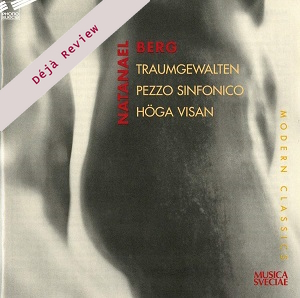
Déjà Review: this review was first published in September 2003 and the recording is still available.
Natanael Berg (1879-1957)
Traumgewalten – symphonic poem (1911)
Symphony No 4 ‘Pezzo Sinfonico’ (1918)
Höga Visan (Song of Songs) (1925)
Karin Ingebäck (soprano), Mathias Zachariassen (tenor)
Swedish Radio Symphony Orchestra & Choir/Manfred Honeck, Mats Rondin, Patrik Ringborg
rec. 2002/03, Berwaldhallen, Sweden
Phono Suecia PSCD721 [73]
Berg was of the same generation as Kurt Atterberg. Indeed, the two were friends. He was largely self-taught and lacked nothing in confidence – a quality that brought him into controversy with the musical establishment of which ultimately he was to form part. He shared a combative nature with Atterberg and Rangström.
Traumgewalten (‘Dream-Obsessed’) is inspired by the poem of the same name by Nikolaus Lenau. It relates to the German expressionist school crossed with Rachmaninov, whose Isle of the Dead is echoed in its pages. The Basque Andrés Isasi was studying in Berlin with Humperdinck during the 1910s and wrote the Berceuse Tragica and Die Sünde in much the same language. Pezzo Sinfonico was written as a bet between Atterberg and Berg to produce the antithesis of the gloomy Scandinavian symphony. Atterberg produced his Fourth Symphony (Piccola) while Berg wrote the four movement Pezzo. This is undemanding, highly skilled and entertaining music skirting around Ketèlbeyan kitsch.
1925, the year of The Song of Songs was also the year of Bantock’s voluptuous work on the same subject. Bantock’s magnum opus also sets Biblical texts but across 150 minutes rather than Berg’s almost forty minutes. Berg’s ‘tapestry’ is in eight episodes. He marshals his resources economically. For the most part these are settings for two voices and orchestra. Unlike the Traumgewalten Berg seems content to work within the silky bonds of tonality, at this stage in his career avoiding even the gentlest dissonance. Certainly he is no Straussian disciple something that cannot be said of Bantock. The choral and vocal writing is done with utmost delicacy, almost simplicity, nothing of the complexity of Zemlinsky’s Lyrische Symphonie here nor of Mahler’s Das Lied von der Erde. While neither soloist is denied operatic high spots (listen to the heroic ring of Zachariassen’s voice in tr. 9) the character of much of the writing avoids the torrid, instead exploring a lower key pastoral simplicity. It is very rarely protesting or tawdrily dramatic. The eight sections are predominantly folksy with a pristine lack of sophistication. Karin Ingebäck makes the links with Brahms’ volkslieder (tr.10 5:03). There are also echoes of Nielsen’s Springtime in Fyn and Pfitzner’s Von Deutsche Seele. Notable episodes include, in track 8, sturdy unison choral singing recalling the treatment of ‘Say heart what will the future bring’ from John Ireland’s These Things Shall Be. At 3:10 in tr. 8 we hear the characteristic descending Rosenkavalier chime. Then there is the satiated-tired trudge at 7:20 on tr.6 pre-echoing Nystroem’s Sinfonia Del Mare and the contemporary Delius Requiem. This resigned gait returns with splendid and all too brief emphasis at the very end of the work.
All three works were smoothly recorded in the ample acoustic of the Berwaldhallen. The booklet is useful though the separation by ten pages of the English translation of Höga Visan from the sung original Swedish was a mistake. The only one in this admirable disc.
Rob Barnett
Help us financially by purchasing from



















